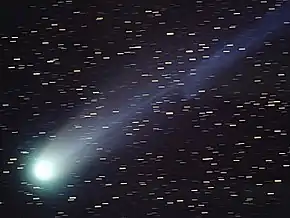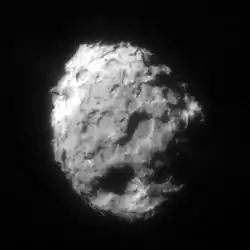C/2015 ER61 (PANSTARRS)
C/2015 ER61 (PANSTARRS) is a comet, inner Oort cloud object, Amor near-Earth asteroid, and possibly a damocloid. When classified as a minor planet, it had the fourth-largest aphelion of any known minor planet in the Solar System, after 2005 VX3, 2012 DR30, and 2013 BL76. It additionally had the most eccentric orbit of any known minor planet, with its distance from the Sun varying by about 99.9% during the course of its orbit, followed by 2005 VX3 with an eccentricity of 0.9973. On 30 January 2016, it was classified as a comet when it was 5.7 AU from the Sun.[6] It comes close to Jupiter, and a close approach in the past threw it on the distant orbit it is on now.
| Discovery | |
|---|---|
| Discovered by | Pan-STARRS 1 (F51) |
| Discovery date | 15 March 2015 |
| Designations | |
| Orbital characteristics[2] | |
| Epoch 7 May 2017 (JD 2457880.5) | |
| Observation arc | 1.96 yr |
| Aphelion | |
| Perihelion | 1.0421 AU |
| Eccentricity | 0.99730 |
| |
| 359.99° | |
| Inclination | 6.3490° |
| 235.21° | |
| 68.197° | |
| Earth MOID | 0.1016 AU[3][4] |
| Mars MOID | <0.00005 AU[4] |
| Jupiter MOID | 0.0794 AU[3][4] |
| Saturn MOID | 0.2869 AU[4] |
| Physical characteristics | |
| Dimensions |
|
| Albedo | ~0.05 (assumed) |
| |
| 12.3[1] | |
Though the comet nucleus was probably mildly active, early asteroidal estimates gave an absolute magnitude (H) of 12.3,[1] which would suggest a nucleus as large as 8–20 km in diameter. But it could easily be half that size due to activity brightening the nucleus.
2017 perihelion
2015 ER61 was discovered on 15 March 2015 when it was 8.44 AU from the Sun,[7] and magnitude 21.5.[6] By early February 2016, the object reached magnitude 20, and made a close approach to Jupiter on 28 March 2016 of 0.9245 AU.[3] This changed its orbit, significantly decreasing its aphelion distance from 1430 AU to ~1200 AU, and as it passes through the inner Solar System its aphelion decreases to 770 AU, and by 2020 will have an aphelion of 854 AU.
The barycentric orbital period will decrease from 19000 years (epoch 1950) to 9000 years (epoch 2050).
As of January 2017, it was magnitude 13, and increasing in brightness. On 4 April 2017, it was detected outbursting to magnitude 6.5. On 19 April 2017, it reached its closest point to Earth of ~1.2 AU. At this point, it was about apparent magnitude 8,[8] and, assuming a size of 20 km, have an apparent size of 19 mas. It came to perihelion (closest approach to the Sun) on 10 May 2017.[2] It will not be 50 AU from the Sun until 2045.
Orbital elements table
| Dist. from Sun |
Event | Epoch | Aphelion (Q) |
Perihelion (q) |
Semi-major axis (a) |
Eccentricity (e) |
Period (p) |
Inclination (i) |
Longitude ascending node (Ω) |
Mean anomaly (M) |
Argument of perihelion (ω) |
|---|---|---|---|---|---|---|---|---|---|---|---|
| (AU) | (AU) | (years) | (°) | ||||||||
| 36.5 | 2000-01-01 | 1423.4 | 1.05378 | 712.2 | 0.99852 | 18,990 | 6.12745 | 239.06 | 359.671 | 63.99 | |
| 20.2 | 2010-01-01 | 1435.4 | 1.05377 | 718.2 | 0.99853 | 19,240 | 6.12732 | 239.03 | 359.862 | 64.01 | |
| 9.01 | 2015-01-01 | 1430.8 | 1.05347 | 715.9 | 0.99853 | 19,140 | 6.12819 | 238.97 | 359.956 | 64.08 | |
| 8.44 | discovery | 2015-03-15 | 1436.1 | 1.05313 | 718.6 | 0.99853 | 19,250 | 6.12879 | 238.95 | 359.960 | 64.11 |
| 6.00 | 2016-01-01 | 1667.3 | 1.04763 | 834.2 | 0.99874 | 24,080 | 6.15827 | 238.25 | 359.980 | 64.92 | |
| 5.204 | Jupiter approach | 2016-03-28 | 1291.9 | 1.04030 | 646.5 | 0.99839 | 16,420 | 6.24250 | 236.73 | 359.976 | 66.64 |
| 2.242 | 2017-01-01 | 324.6 | 1.03505 | 162.8 | 0.99364 | 2,080 | 6.34928 | 235.27 | 359.939 | 68.46 | |
| 1.079 | Earth approach | 2017-04-04 | 164.3 | 1.03830 | 82.7 | 0.98744 | 750 | 6.34595 | 235.27 | 359.953 | 68.30 |
| 1.0397 | Perihelion | 2017-05-10 | 210.0 | 1.03973 | 105.5 | 0.99015 | 1,080 | 6.34423 | 235.25 | 0.0004 | 67.92 |
| 3.437 | 2018-01-01 | 1091.1 | 1.04449 | 546.1 | 0.99809 | 12,750 | 6.34438 | 235.23 | 0.018 | 68.27 | |
| 9.78 | 2020-01-01 | 857.8 | 1.04583 | 429.4 | 0.99756 | 8,890 | 6.34009 | 235.21 | 0.107 | 68.29 | |
| 56.03 | 2050-01-01 | 854.6 | 1.04649 | 427.8 | 0.99755 | 8,840 | 6.33543 | 235.18 | 1.329 | 68.34 | |
Comparison

Notes
^ assuming an inactive nucleus and a comet-like albedo of 0.05
^ ^ Because 2015 ER61's orbit takes it so far from the Sun, a more accurate value for its orbit is a barycentric solution. Additionally, a close approach to Jupiter in 2016, and a travel through the inner solar system in 2017 drastically changes its orbit. Therefore, orbits for 2000–2016 and 2018–2100 are provided, respectively.
References
- Archive of JPL 13 (2015-Jun-04) as Amor near-Earth object
- "C/2015 ER61 (PANSTARRS) Orbit". Minor Planet Center. Archived from the original on 2 March 2017. Retrieved 2 March 2017.
- "JPL Small-Body Database Browser: (2015 ER61)" (last observation: 2016-01-23; arc: 1 yr). Jet Propulsion Laboratory. Archived from the original on 24 June 2015.
- Gray, Bill. "Find_Orb Orbit Determination Software". Project PLuto. Retrieved 22 April 2019.
- "Glossary: Absolute Magnitude (H)". JPL. NASA. Retrieved 14 September 2015.
- "MPEC 2016-C01 : COMET C/2015 ER61 (PANSTARRS)". IAU Minor Planet Center. 1 February 2016. Retrieved 1 February 2016. (CK15E61R)
- Meech, Karen Jean; Sorli, Kya; Kleyna, Jan; Keane, Jacqueline; Bauer, James M.; Micheli, Marco; Schambeau, Charles Alfred; Sarid, Gal; Hainaut, Olivier; Yang, Bin; Wainscoat, Richard J.; Boe, Benjamin; Kramer, Emily A.; Bhatt, Bhuwan; Sahu, Devendra (2016). "Watching a Long Period Comet Turn On - C/2015 ER61 (PANSTARRS)". Aas/Division for Planetary Sciences Meeting Abstracts #48. 48: 308.06. Bibcode:2016DPS....4830806M.
- Seiichi Yoshida (27 February 2007). "C/2015 ER61 ( PanSTARRS )". Seiichi Yoshida's Comet Catalog. Retrieved 2 March 2017.







